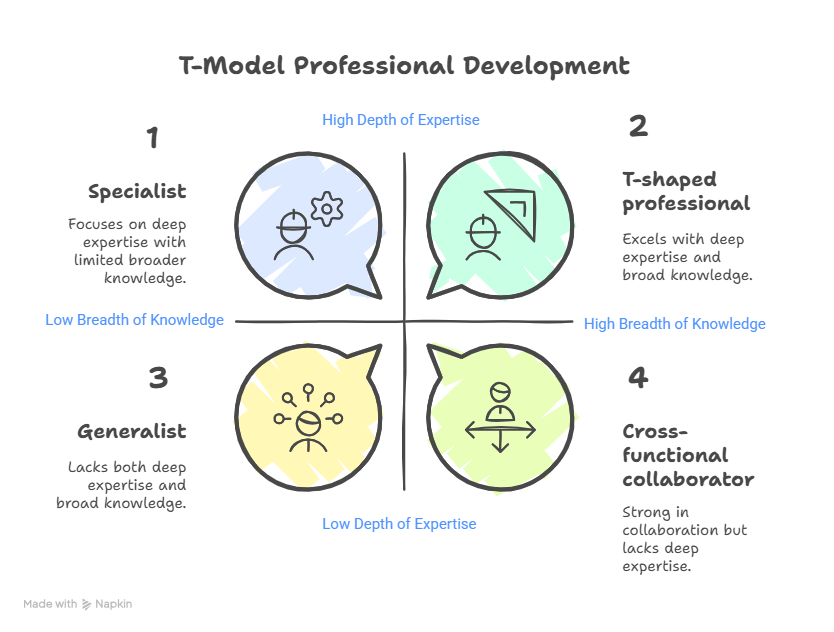Discover how T-shaped professionals are driving innovation and transformation in Global Capability Centers (GCCs) and GBS models.

In a world where the pace of change outstrips traditional learning curves, organizations seek professionals who are not just specialists, but integrators. T-Model is a transformative approach to skills development, shaping the future of talent in Global Capability Centers (GCCs) and Global Business Services (GBS).
What is the T-Model?
At its core, the T-Model represents a balanced approach to talent development:
- The vertical bar of the “T” symbolizes deep expertise in a particular domain.
- The horizontal bar reflects the breadth of knowledge across adjacent areas, enabling collaboration, adaptability, and cross-functional thinking.
This fusion creates T-shaped professionals who are both masters in their field and fluent collaborators in broader organizational ecosystems.
Why It Matters More Than Ever
In traditional service delivery models, narrow specialization was enough. But in today’s integrated GBS and GCC environments, where automation, digital transformation, and cross-functional collaboration are the norm, this model falls short.
T-shaped professionals:
- Can bridge silos between finance, IT, procurement, and HR.
- Lead end-to-end transformation projects with contextual awareness.
- Adapt rapidly to emerging tools like AI, GenAI, data science, and cloud platforms.
- Contribute not only to execution but also to strategy, design, and innovation.
Real-World Example
Imagine a GCC finance leader whose deep expertise lies in the Record-to-Report (R2R) domain. This includes:
- Journal entry management
- Month-end close
- Intercompany reconciliations
- Financial reporting and compliance
But their horizontal knowledge spans across:
- SAP and Oracle ERP integration
- FP&A basics, including variance analysis and commentary
- Tax and statutory compliance awareness
- Automation tools like, Alteryx, or Power BI
- Change management and stakeholder communication
- Digital Tools like, BlackLine, Celonis, SNOW, Workiva
This leader doesn’t just “close the books.” They:
- Collaborate with tax and FP&A teams to align reporting outputs
- Drive automation of reconciliations
- Lead R2R process improvements globally
- Serve as a transformation partner to the CFO’s office
By being T-shaped, they operate not only as an expert in accounting but also as a connector across business functions, capable of scaling the impact of the GCC beyond just transactional excellence.
How GCCs Are Using the T-Model
Leading GCCs are moving away from the “factory model” of roles. Instead, they are:
- Mapping roles to T-profiles, not just job descriptions.
- Investing in cross-domain upskilling (e.g., combining finance with analytics or procurement with ESG).
- Creating career pathways that encourage both vertical mastery and horizontal curiosity.
Building a T-Shaped Workforce: Key Enablers
- Learning Culture: Encourage employees to explore beyond their primary role.
- Mentorship & Mobility: Let deep experts collaborate across towers through temporary rotations or strategic projects.
- Tech Enablement: Equip teams with tools that connect dots across the organization.
- Leadership by Example: Senior leaders must embody T-shaped behavior—deep in vision, broad in collaboration.
T-Model vs. I-Model vs. Pi-Model
| Model | Description | Strength |
|---|---|---|
| I-Model | Deep expertise in one domain | Excellent for specialists |
| T-Model | Deep + broad collaboration skills | Best for cross-functional teams |
| Π (Pi)-Model | Depth in two areas + breadth | Ideal for leadership, hybrid roles |
Final Thoughts
The T-Model is more than a skill chart—it’s a mindset. As GCCs and GBS units shift from being cost centers to value creators and innovation hubs, the need for versatile, collaborative, and adaptive talent is critical.
In the age of AI, automation, and global agility, the most valuable professionals will not just know “how” but also how to work with everyone else who does.
#GCC #GBS #TModel #CFO #Transformation #RecordToReport